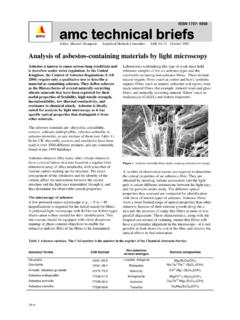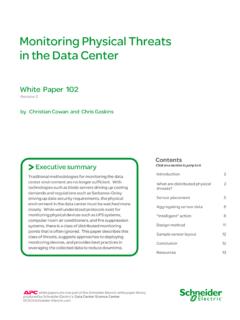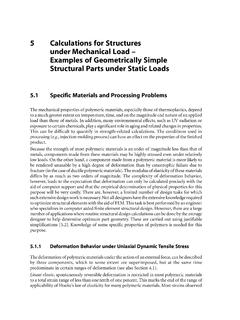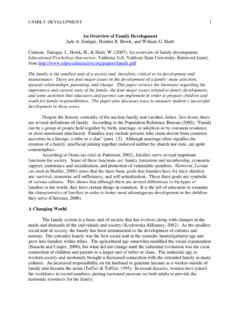Transcription of The concrete conundrum - Royal Society of …
1 62 | Chemistry World | March concrete conundrum concrete is the single most widely used material in the world and it has a carbon footprint to match. James Mitchell Crow looks at some of the approaches being used to ease the material s environmental impactACITORE | 6219/02/2008 10:42:24 Chemistry World | March 2008 | 63 has a problem. Already pilloried through its use in countless architectural eyesores, from tower blocks to carparks, concrete s environmental credentials are also now coming under scrutiny. The material is used so widely that world cement production now contributes 5 per cent of annual anthropogenic global CO2 production, with China s booming construction industry producing 3 per cent alone.
2 And the problem looks set to get worse: already produced in over 2 billion tonne quantities per year, by 2050, concrete use is predicted to reach four times the 1990 level. The reason there s so much concrete is because it is in fact a very low impact material, says Karen Scrivener, head of the construction laboratory at the Swiss Federal Institute of Technology, Lausanne. If you replace concrete with any other material, it would have a bigger carbon footprint. Many people have the idea that if you built in steel you d make things better but in fact you d make things worse. The reason concrete has a big carbon footprint as a whole is that there are just such huge quantities used.
3 concrete is used in such large amounts because it is, simply, a remarkably good building material: not just for basic road construction, but also for rather more glamorous projects. The Burj Dubai skyscraper, still under construction but already well over half a kilometre high the final height remains secret, but the building is set to dwarf all other man-made structures relies on a highly flowable concrete mixture that doesn t harden before it can be pumped to the top of the tower, yet forms a strong and robust final product. And Japan s construction industry has pioneered ultra-strength varieties from which to build its earthquake-proof bridges, and the Tokyo apartment blocks that form some of the most expensive real estate in the have been using concrete in their pioneering architectural feats for millennia.
4 The basic ingredients sand and gravel (aggregate), a cement-like binder, and water were being mixed at least as far back as Egyptian times. The Romans are well-documented masters of the material, using it to create such wonders as the Pantheon in Rome, topped with its gravity-defying concrete dome: now over 2000 years old but still the world s largest non-reinforced concrete the loss of Roman concrete expertise as the Empire fell into decline, concrete s secrets didn t re-emerge until just 200 years ago. Modern concrete was born in the early nineteenth century, with the discovery of Portland cement, the key ingredient used in concretes today.
5 The process of roasting, and then grinding to a powder, limestone and clay to make artificial stone was patented in 1824 by Joseph Aspidin of Leeds, UK, and later refined by his son William into a material very close to the cement used main reaction occurring in Aspidin s kiln was the formation of calcium silicates, from calcium carbonate (limestone) and silicates that make up clay. At temperatures approaching 1000oC, the two raw materials break down into their component oxides and as the temperature rises further, then combine into di- and tri-calcium silicate. The lesser quantities of iron and aluminium in the clay also react with calcium, giving the minor components of Portland cement.
6 Finally, this mixture, called clinker, is ground to a powder, and gypsum is convert this powdery mixture into a concrete , which Aspidin senior claimed was as beautiful as Portland stone (hence its name), In short concrete production contributes 5 per cent of annual anthropogenic global CO2 production, mainly because such vast quantities are used Humans have used concrete for millennia its basic ingredients date back to ancient Egypt CO2 is a product of the main reaction that makes cement concrete s key ingredient Development of new concrete additives could produce a stronger, more workable material whilst reducing the amount of cement required and the resulting CO2 emissions The reason concrete has such a big carbon footprint is because such huge quantities are used Already 605 metres high.
7 The Burj skyscraper in Dubai will be the world s tallest building 6319/02/2008 10:42:4964 | Chemistry World | March add water and aggregate. The resulting calcium silicate hydrates form an extended network of bonds which bind together the solid aggregate. However, the exact role of the lesser components of the cement remains the chemistry of concrete may still not be entirely understood, what has become increasingly clear is the material s environmental impact. The rule of thumb is that for every tonne of cement you make, one tonne of CO2 is produced, says Marios Soutsos, who studies concrete at the University of Liverpool, UK. Modern cement kilns are now more efficient, and produce about 800kg of CO2 per tonne but that is still a big emission.
8 concrete production is responsible for so much CO2 because making Portland cement not only requires significant amounts of energy to reach reaction temperatures of up to 1500oC, but also because the key reaction itself is the breakdown of calcium carbonate into calcium oxide and CO2. Of those 800kg of CO2, around 530kg is released by the limestone decomposition reaction complex mixSeveral ways of reducing the environmental impact of concrete are now being investigated one possibility being to produce ultra-strong varieties so less concrete is required to do the same strong concrete is a fine balancing act. Too many pores filled with unreacted water weaken the final structure, but a certain amount of water is required to keep the mixture workable.
9 However, this threshold of workability can be lowered using additives called concrete lorries that rumble along our roads today are likely to be carrying a complex mixture of chemical additives, in addition to the basic ingredients of concrete . But like most aspects of concrete chemistry, this is not a new development the Romans are known to have included additives such as animal blood to improve concrete performance, and the Chinese added sticky rice to their mixtures when building the Great Wall during the Ming dynasty. People do dispute this, but I would say the water: cement ratio for complete hydration was , said Marios Soutsos. But to get the strength you don t need to have complete hydration.
10 We are going down to a ratio of , with admixtures, and that gives higher strength than a completely hydrated system. The only thing preventing us from going below that is the workability of the concrete . More efficient chemical admixtures may allow us to. One company hoping to extend that limit further is BASF. Their construction chemicals business greatly expanded by the purchase of Degussa s construction business on 1 July 2006 is one of the main drivers of admixture chemistry, according to Soutsos. While there have been several families of concrete additives used by the construction industry since animal blood went out of fashion, the most recently developed, and best performing, are the polycarboxylate ethers (PCEs), says Sven Asmus, head of technical services and development of admixture systems at BASF, based in China, where close to half of the world s cement is produced.















